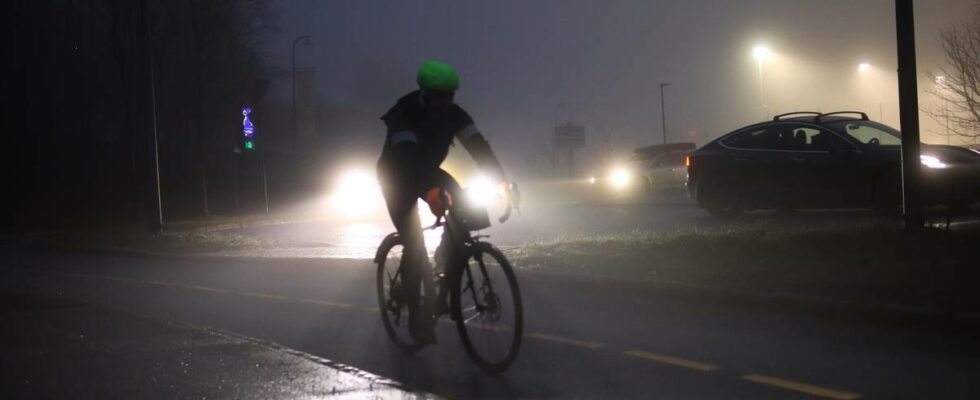On Thursday, news published a case showing a cyclist being attacked by a motorist. Many people have reacted to the video which shows a motorist attacking a cyclist on Mosseveien in Oslo. TO ATTACK: Wagon train driver Knut Berge’s dashboard camera captured the incident on Mossevegen in Oslo. Both the cycling and car organizations agree that something must be done. Tougher climate – Fortunately, it is rare that we see it become as serious as this, says Jan Harry Svendsen, who is an advisor for traffic safety at NAF. NAF does not have figures that there are more unwanted incidents, but there are many on the road, a harsher tone is seen both in traffic and in online discussion forums. TOUGH: The climate between motorists and cyclists has become tougher in recent years, says Jan Harry Svendsen in NAF, who wants to better distinguish the groups of road users from each other. Photo: Tomas Berger / Tomas Berger / news – There is no doubt that there has been a tougher climate between cyclists and motorists, says Svendsen. More cyclists Both Oslo and several other Norwegian cities have made more provision for cycling in recent years. Oslo has built or upgraded a total of around 155 kilometers of cycle paths since 2015. The aim is for more people to walk and cycle rather than drive. INVESTMENT: More cycle paths and bridges, such as this one on Ring 3 in Oslo, have led to many more cycling than before, also in winter. Photo: Snorre Tønset / Snorre Tønset The investment has paid off. There are almost 40 per cent more cyclists on weekdays than ten years ago. At the same time, the risk of accidents has decreased sharply, according to an evaluation carried out by EY for the municipality of Oslo. Nevertheless, NAF believes that many cyclists feel unsafe when cycling, especially where there is heavy traffic. Therefore, cyclists and motorists should be better separated from each other, NAF believes. – A physical separation would have been good. It would have been good for motorists too. Then it would have become more predictable who the cyclists are, says Jan Harry Svendsen in NAF. Red asphalt not enough Oslo has a goal that 25 percent of work journeys should be by bicycle during 2025. Much stronger measures are needed if it is to be realistic to reach the goal, Naf believes. – It doesn’t work to just lay a bit of red asphalt somewhere and think that now we are in a cycling city, says half-Danish Jan Harry Svendsen. SKILJE: Red asphalt is not enough, says NAF. There must more often be a physical separation between the cycle lane and the roadway for cars. Photo: Snorre Tønset / Snorre Tønset He recommends that the politicians go to cycling country Denmark on a study trip to see how they do it. – It must be done in a way that ensures accessibility for all groups of road users, whether they are motorists, cyclists or pedestrians, says Svendsen. Weakness in cycle lanes The Cyclist Association agrees that many people experience cycle lanes in Norwegian cities as a problem. – The cycle paths in many of the cities are piecemeal and divided, and rarely connected, says Eline Oftedal, secretary general of the Cyclist Association. She has experienced that herself: – As a cyclist, I myself experience that there is often a cycle path, and then suddenly the cycle path ends and turns into the road. She believes that leads to dangerous situations. DIFFICULTY: Eline Oftedal, general secretary of the Cyclist Association, believes that many people think it is difficult to cycle in the cities. Oftedal believes that good arrangements for cyclists reduce conflicts in traffic. She also points to countries with many cyclists and a clear cycling culture, such as Denmark, where everyone has a clear place. – When cycle lanes end abruptly, cyclists have to make difficult choices, which can cause confusion and conflicts. The Cyclists’ Association has recorded to the city council’s platform that they want the cycle paths to be connected. – Where the cars know where they are supposed to be, and the cyclists know where they are supposed to be, you avoid conflicts and get a much better culture. Take more care – The big picture shows that there is a great degree of respect and care between cyclists and motorists, says Eline Oftedal. CARE: Motorists and cyclists must take more care of each other, NAF believes. Photo: Snorre Tønset / Snorre Tønset Jan Harry Svendsen in NAF believes there is much to be done in that area. – Motorists and other road users give each other room and make sure that everyone arrives safely. If everyone does that, and doesn’t always stand up to their rights, I think we will all get a lot further as road users, says Svendsen in NAF. Published 14.11.2024, at 21.57
ttn-69
NAF wants to separate motorists and cyclists from each other – news Norway – Overview of news from different parts of the country

